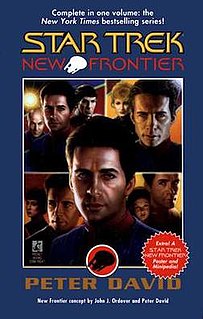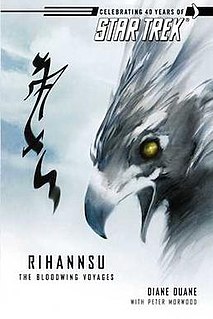
Star Trek: The Animated Series (TAS), originally airing as Star Trek and as The Animated Adventures of Gene Roddenberry's Star Trek, is an American animated science fiction television series created by Gene Roddenberry. It originally aired Saturday mornings from September 8, 1973, to October 12, 1974, on NBC, spanning 22 episodes over two seasons. The second series in the Star Trek franchise, it features the same characters as Star Trek: The Original Series. Set in the 23rd century, when Earth is part of a United Federation of Planets, it follows the adventures of the Starfleet vessel USS Enterprise as it explores the Milky Way galaxy.
Robert T. April is a fictional character in the Star Trek universe. April is listed in the Star Trek Chronology, The Star Trek Encyclopedia and at startrek.com as the Enterprise's first commanding officer, preceding Captain Christopher Pike.
"Encounter at Farpoint" is the pilot episode and series premiere of the American science fiction television series Star Trek: The Next Generation, which premiered in syndication on September 28, 1987. It was written by D. C. Fontana and Gene Roddenberry and directed by Corey Allen. Roddenberry was the creator of Star Trek, and Fontana was a writer on the original series. It was originally aired as a two-hour TV movie, and subsequent reruns typically split the episode into two parts.

Star Trek: New Frontier is a series of interlinked novels written by Peter David, published by Simon & Schuster imprints, Pocket Books, Pocket Star, and Gallery Books, from 1997 to 2015. New Frontier was the first Star Trek tie-in fiction property not to be based on a television series. The series was created by John J. Ordover.

Star Trek: Rihannsu is a series of interlinked novels, written by Diane Duane and Peter Morwood, published by Pocket Books from 1984 to 2006. The series name was retroactively applied to the first novels with the release of new installments in 2000. A fifth novel was published in 2006.
The Star Trek franchise has produced a large number of novels, comic books, video games, and other materials, which are generally considered non-canon.
The Star Trek canon is the set of all canonical material in the Star Trek universe. The official Star Trek website defines canon as comprising the television series and feature films of the franchise.
Star Trek: Challenger is a spin-off series of Star Trek novels published by Pocket Books in the United States as part of Pocket's line. Based on the titular TV series created by Gene Roddenberry, the series was created by Pocket editor John J. Ordover and writer Diane Carey, and was a continuation of the six-book storyline, Star Trek: New Earth. The sixth and final New Earth book was subtitled Challenger, and served as a springboard for Star Trek: Challenger. It was published on August 1, 2000.

Mission to Horatius is a novel based on the American science fiction television series Star Trek: The Original Series. It was published in 1968 by Whitman, and was the first original novel based on the series; the first novel for adult audiences, Spock Must Die!, was not published until February 1970. Mission to Horatius details the adventures of the crew of the U.S.S. Enterprise investigating where a distress signal had originated, resulting in them engaging with several different human colonies.
John J. Ordover Is a New York Area stand-up comic, and is the American founder and chief executive officer of JJO Marketing, a digital art gallery owner, and is best known for being an editor at Pocket Books from 1992 to 2003 overseeing the Star Trek franchise licensed novels, and from 2003 to 2005 Editor-In-Chief of Phobos Books. In 2018 he released Lie There and Lose Weight: How I Lost 100 Pounds by Doing Next to Nothing, a weight loss memoir, from Wilder Publications, ISBN 9781-5154-1933-4. Since losing weight Ordover has added acting to his creative list, including appearances on 2018–2019 season of The Marvelous Mrs. Maisel, Madam Secretary, Law & Order: SVU, New Amsterdam, Manifest and Instinct
Diane L. Carey-Brodeur is an American fiction writer, publishing under the pen names Lydia Gregory, Diane Carey, and D. L. Carey.

Star Trek: Strange New Worlds is a science fiction anthology series of licensed, fan-written, short stories based on, and inspired by, Star Trek and its spin-off television series and films. The series was published by Simon & Schuster, from 1996 to 2016, edited by Dean Wesley Smith, with assistance from John J. Ordover and Paula M. Block. The collected stories were submitted by amateur writers.

Killing Time is a Star Trek: The Original Series novel written by Della Van Hise and published by Pocket Books in 1985. The original manuscript had Kirk/Spock slash fiction elements, and these were requested to be removed by Paramount. However, they were not removed, and 250,000 copies were printed. These romantic undertones between Spock and James T. Kirk were brought to the attention of the office of the creator of Star Trek, Gene Roddenberry, who made Pocket Books recall the first edition. This edition subsequently became a collector's item, with more than fifty changes made to a revised version.

Voyages of Imagination: The Star Trek Fiction Companion (2006) is a reference work by Jeff Ayers published by Pocket Books. The book contains entries on the production and publication of Star Trek tie-in novels published from 1967 to 2006. Included are brief synopses of plots for each featured novel.

Mosaic is a novel based on the American science fiction television series Star Trek: Voyager. It was written by Jeri Taylor, who was executive producer of the show for the first five seasons, and was published by Pocket Books in 1996. The novel describes the backstory of Captain Kathryn Janeway, from when she was a small child, to working alongside Owen Paris and finally when she was made captain of her first ship.

Star Trek: The God Thing is an unproduced film script written by Star Trek series creator Gene Roddenberry. Following the success of Star Trek in broadcast syndication during the early 1970s, Paramount Pictures sought to produce a feature film based on the property. The film's plot follows the Enterprise crew after the events of The Original Series: when an alien entity declares itself God and begins travel to Earth, Admiral James T. Kirk reunites the crew, who send it back to its own dimension. Roddenberry completed the story on June 30, 1976, but Paramount rejected the script for reasons Roddenberry attributed to the religious views of company executives. Story elements were used in Star Trek V: The Final Frontier.









